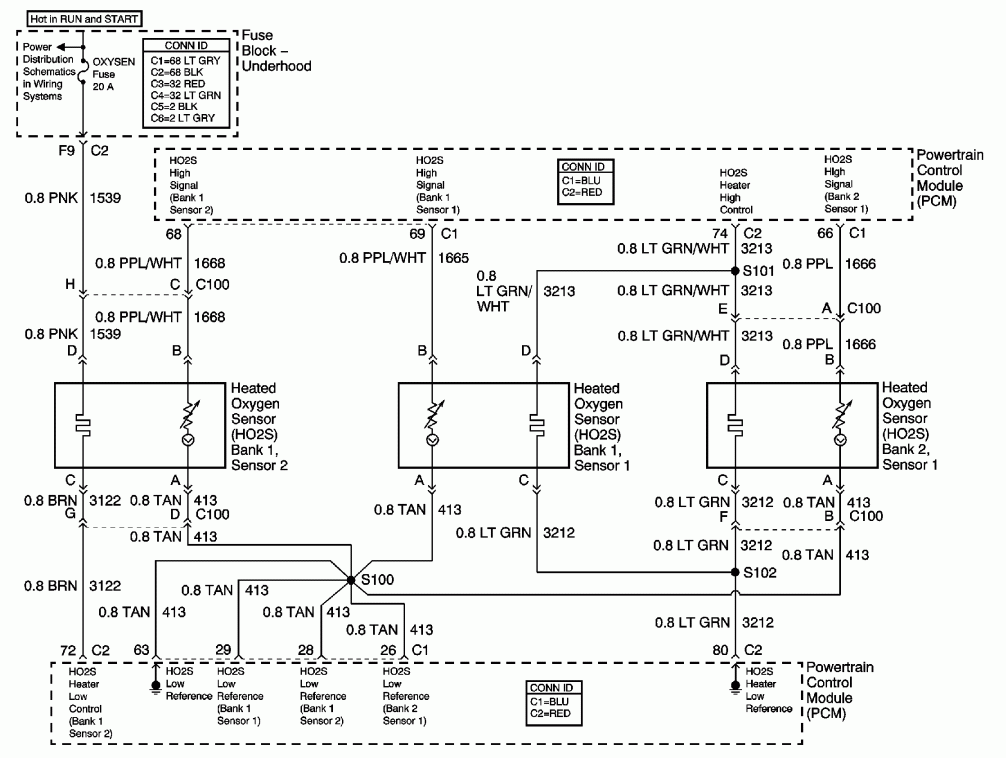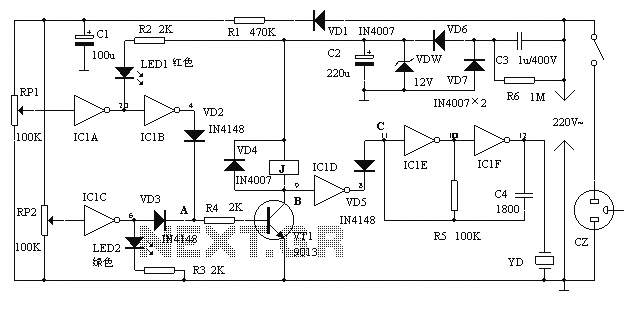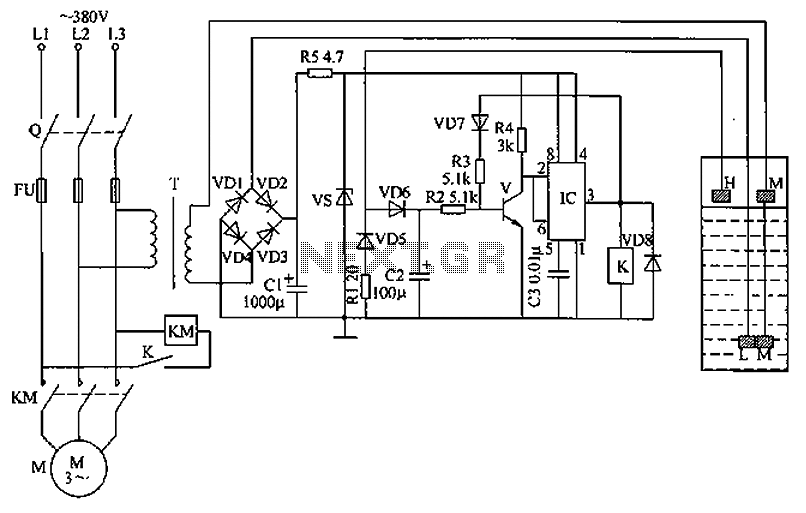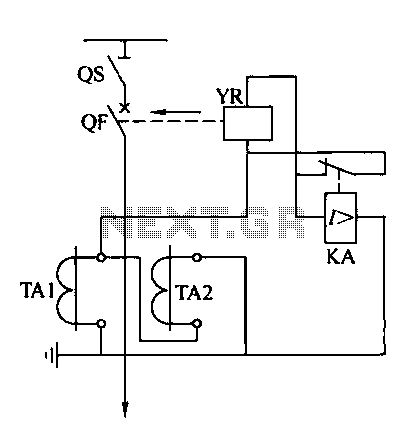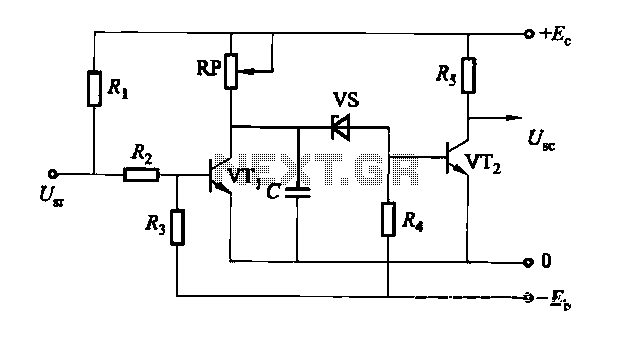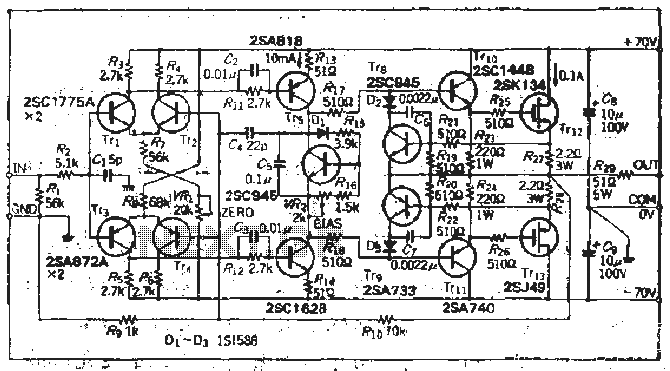
Electrification Circuit Unit
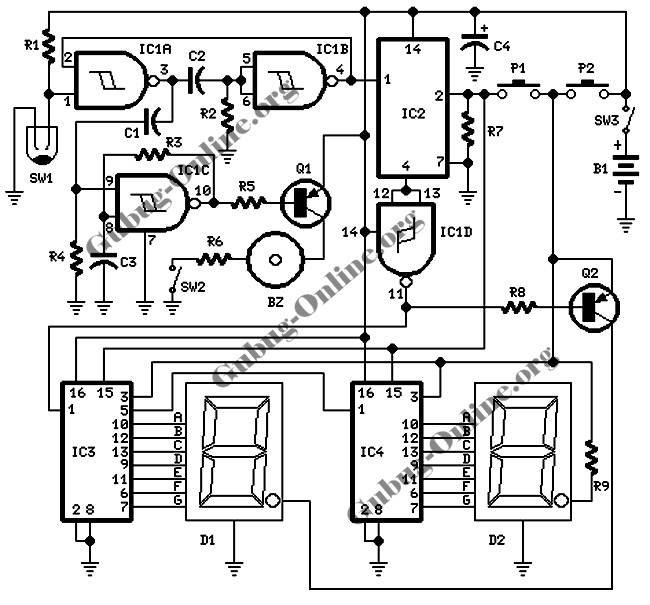
This circuit design is intended for conducting harmless experiments with high-voltage pulses, functioning similarly to an electrified fence generator. The pulse repetition frequency (PRF) is determined by the time constant of the resistor-capacitor network R1-C3 in the feedback loop of operational amplifier IC1a, yielding a frequency of approximately 0.5 Hz with the specified component values. The subsequent stage, operational amplifier IC1b, converts the rectangular signal into narrow pulses. The differentiating network R2-C4, along with the switching threshold of the Schmitt trigger inputs of IC1b, sets the pulse period to about 1.5 ms. The output from IC1b is directly connected to the gate of thyristor THR1, triggering this device with the generated pulses. The required high voltage is produced using a small mains transformer, with its secondary winding utilized as the primary. This winding, together with capacitor C2, creates a resonant circuit. Capacitor C3 is charged to the supply voltage (12 V) through resistor R3. When a pulse from IC1b triggers the thyristor, the capacitor discharges through the secondary winding of the transformer. The energy stored in the capacitor is not dissipated but is instead stored in the magnetic field generated by the transformer as current flows. When the capacitor discharges, the current stops, causing the magnetic field to collapse. This collapse induces a counter electromotive force (e.m.f.) in the transformer winding that opposes the previously applied voltage. Consequently, the current direction remains unchanged, but capacitor C2 becomes negatively charged. Once the magnetic field of the transformer returns the stored energy to the capacitor, the current direction reverses, and the negatively charged capacitor discharges through diode D1 and the secondary winding of the transformer. As soon as the capacitor begins discharging, there is no current flowing through the thyristor, causing it to turn off. As C2 continues to discharge, diode D1 becomes reverse-biased, breaking the current loop to the transformer, allowing capacitor C3 to recharge to 12 V via resistor R3. This cycle repeats with each pulse from IC1b.
The circuit operates on the principle of energy transfer between the capacitor and the transformer, utilizing the characteristics of the thyristor for switching. The design emphasizes safety by ensuring that the high-voltage pulses are generated and controlled in a manner suitable for experimentation without risk. The use of a Schmitt trigger allows for clean transitions and pulse shaping, which is critical for the reliable operation of the thyristor. The resonant circuit formed by the transformer and capacitor C2 enhances the efficiency of energy transfer, allowing for effective high-voltage pulse generation. The careful selection of component values is crucial to achieving the desired PRF and pulse width, ensuring that the circuit performs as intended while maintaining operational safety.Here`s a design circuit that is intended for carrying out harmless experiments with high-voltage pulses and functions in a similar way as an electrified fence generator. The p. r. f. (pulse repetition frequency) is determined by the time constant of network R1-C3 in the feedback loop of op amp IC1a: with values as specified, it is about 0.
5 Hz. The stage following the op amp, IC1b, converts the rectangular signal into narrow pulses. Differentiating network R2-C4, in conjunction with the switching threshold of the Schmitt trigger inputs of IC1b, determines the pulse period, which here is about 1. 5 ms. The output of IC1b is linked directly to the gate of thyristor THR1, so that this device is triggered by the pulses.
Here`s the figure of the schematic diagram; The requisite high voltage is generated with the aid of a small mains transformer, whose secondary winding is here used as the primary. This winding, in conjunction with C2, forms a resonant circuit. Capacitor C3 is charged to the supply voltage (12 V) via R3. When a pulse output by IC1b triggers the thyristor, the capacitor is discharged via the secondary winding.
The energy stored in the capacitor is, however, not lost, but is stored in the magnetic field produced by the transformer when current flows through it. When the capacitor is discharged, the current ceases, whereupon the magnetic field collapses. This induces a counter e. m. f. in the transformer winding which opposes the voltage earlier applied to the transformer. This means that the direction of the current remains the same. However, capacitor C2 is now charged in the opposite sense, so that the potential across it is negative.
When the magnetic field of the transformer has returned the stored energy to the capacitor, the direction of the current reverses, and the negatively charged capacitor is discharged via D1 and the secondary winding of the transformer. As soon as the capacitor begins to be discharged, there is no current through the thyristor, which therefore switches off.
When C2 is discharged further, diode D1 is reverse-biased, so that the current loop to the transformer is broken, whereupon the capacitor is charged to 12 V again via R3. At the next pulse from IC1b, this process repeats itself. 🔗 External reference
The circuit operates on the principle of energy transfer between the capacitor and the transformer, utilizing the characteristics of the thyristor for switching. The design emphasizes safety by ensuring that the high-voltage pulses are generated and controlled in a manner suitable for experimentation without risk. The use of a Schmitt trigger allows for clean transitions and pulse shaping, which is critical for the reliable operation of the thyristor. The resonant circuit formed by the transformer and capacitor C2 enhances the efficiency of energy transfer, allowing for effective high-voltage pulse generation. The careful selection of component values is crucial to achieving the desired PRF and pulse width, ensuring that the circuit performs as intended while maintaining operational safety.Here`s a design circuit that is intended for carrying out harmless experiments with high-voltage pulses and functions in a similar way as an electrified fence generator. The p. r. f. (pulse repetition frequency) is determined by the time constant of network R1-C3 in the feedback loop of op amp IC1a: with values as specified, it is about 0.
5 Hz. The stage following the op amp, IC1b, converts the rectangular signal into narrow pulses. Differentiating network R2-C4, in conjunction with the switching threshold of the Schmitt trigger inputs of IC1b, determines the pulse period, which here is about 1. 5 ms. The output of IC1b is linked directly to the gate of thyristor THR1, so that this device is triggered by the pulses.
Here`s the figure of the schematic diagram; The requisite high voltage is generated with the aid of a small mains transformer, whose secondary winding is here used as the primary. This winding, in conjunction with C2, forms a resonant circuit. Capacitor C3 is charged to the supply voltage (12 V) via R3. When a pulse output by IC1b triggers the thyristor, the capacitor is discharged via the secondary winding.
The energy stored in the capacitor is, however, not lost, but is stored in the magnetic field produced by the transformer when current flows through it. When the capacitor is discharged, the current ceases, whereupon the magnetic field collapses. This induces a counter e. m. f. in the transformer winding which opposes the voltage earlier applied to the transformer. This means that the direction of the current remains the same. However, capacitor C2 is now charged in the opposite sense, so that the potential across it is negative.
When the magnetic field of the transformer has returned the stored energy to the capacitor, the direction of the current reverses, and the negatively charged capacitor is discharged via D1 and the secondary winding of the transformer. As soon as the capacitor begins to be discharged, there is no current through the thyristor, which therefore switches off.
When C2 is discharged further, diode D1 is reverse-biased, so that the current loop to the transformer is broken, whereupon the capacitor is charged to 12 V again via R3. At the next pulse from IC1b, this process repeats itself. 🔗 External reference
